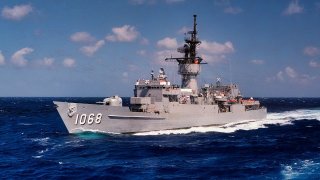Knox-Class Frigate: The U.S. Navy's Big Mistake?
Interestingly, despite their long operational service with several different navies through multiple conflicts, the Knox-class frigates have never fired a shot in anger.
Knox-Class Frigate – McNamara's Folly? - Today the Republic of China (ROC) Navy operates six Chi Yang-class frigates and there is speculation that the vessels could be upgraded to receive the Hsiung Feng III ("Brave Wind III") surface-to-surface anti-ship missile. It would greatly enhance the capabilities of the aging warships that first entered service as the Knox-class with the United States Navy in the 1960s.
Developed as the largest of the U.S. Navy's second-generation anti-submarine warfare (ASW) escorts, the vessels were originally laid down as ocean escorts (formerly designated destroyer escorts) before being redesignated as frigates. These were also the largest class of fleet warships constructed by the United States since the Second World War, while they were also the final U.S. warships equipped with oil-fired boilers and for a time, they were also the last U.S. destroyer-type vessels with steel hulls – although the ships did have aluminum superstructures.
Enter the Knox-class
The Knox-class was developed as a response to the unforeseen expenses that became apparent with the preceding Brooke-class frigates, which were armed with the Tartar Surface-to-Air Missile (SAM) system. That program was cut to just six of a planned 19 vessels, and then Secretary of Defense Robert S. MacNamara directed the U.S. Navy to build a class of gun frigates instead, to keep the program cost down.
The resulting design actually changed little from the Brooke-class. While it omitted the Tartar launcher and guidance radars, the Knox-class was initially meant to employ the MIM-46 Mauler SAM system along with a more elaborate lightweight boiler system. However, problems with both of those systems resulted in the same boilers as the Charles F. Adams-class destroyers being used instead, while SAM armament was omitted altogether.
There were numerous other pros and cons.
The ships displaced 4,065 long tons (4,130 tons) under full load; and had a length of 438 feet, nine inches, with a beam of 46 feet, nine inches. The Westinghouse steam turbine gave the Knox-class frigates a top speed of 27 knots and they had a range of 4,500 nautical miles.
The crew consisted of 17 officers and 240 enlisted sailors, who typically found the Knox-class vessels to be roomier than these destroyers, and for that reason, the ships were generally liked. However, the frigates also lacked redundancy – as their single screw made breakdown a concern.
The main gun of the Knox class was the Mk.42 127 mm/L54 dual-purpose gun, in a single-gun turret. It could traverse through +/- 150 degrees at up to 40 degrees per second, while it could elevate from -15 / +85 degrees at up to 25 degrees per second. The weapon was highly effective against ships, aircraft, and shore targets like, and even some anti-ship missiles. However, that lone five-inch gun could jam during continuous fire.
As a result, the ships became known to a generation of destroyermen as "McNamara's Folly."
That attitude gradually changed over the years, however, as the frigates received numerous upgrades that included an RGM-84 Harpoon in Mk 16 launcher, and later a 20mm Mk 15 Phalanx system. More importantly, the Knox-class proved their worth as rugged and reliable escort vessels.
Yet, the U.S. Navy's leadership remained less fond of the frigates, and as a result, the Knox-class was retired from U.S. service unusually early. None of the warships remained operational for more than 23 years with the U.S. Navy, and nine went to the breakers – while six others served as target ships.
As the frigates had decades of longevity left on them, a total of 31 of the 46 built were passed on to foreign navies, including those of the Republic of China (Taiwan), Egypt, Greece, Mexico, Thailand, and Turkey. In addition, five modified Knox-class frigates were built in Spain for the Spanish Navy as the Baleares-class. All of the Spanish warships have since been retired from service.
Interestingly, despite their long operational service with several different navies through multiple conflicts, the Knox-class frigates have never fired a shot in anger. That fact could, of course, change if the People's Republic of China were to mount an invasion of Taiwan – and while old, they shouldn't be underestimated.
Author Experience and Expertise
Peter Suciu is a Michigan-based writer. He has contributed to more than four dozen magazines, newspapers, and websites with over 3,200 published pieces over a twenty-year career in journalism. He regularly writes about military hardware, firearms history, cybersecurity, politics, and international affairs. Peter is also a Contributing Writer for Forbes and Clearance Jobs. You can follow him on Twitter: @PeterSuciu.


